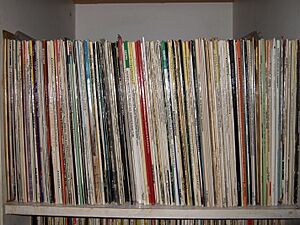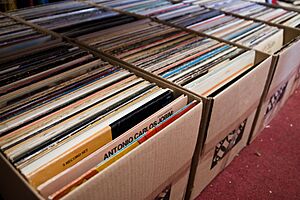Record collecting facts for kids
Record collecting is a fun hobby where people gather sound recordings. Most often, these are music records, but sometimes they can be poetry, speeches, or even interesting sounds. While many collectors focus on vinyl records, you can collect recorded music in any format.
What Can You Collect?
A record collection can focus on many different things. Here are some ideas for what you might collect:
- Music Styles: You could collect records from specific genres like rock, pop, or hip-hop.
- Artists: Some collectors focus on all the music by their favorite artists or bands.
- Record Companies: You might collect records released by certain record labels.
- Time Periods: You could gather music from a specific decade, like the 1980s, or a certain music scene.
- Formats: Collectors often specialize in one type of record, such as:
- Special Records: Some people look for unusual records. These might be odd shapes, bright colors, or different sizes. They could also be records with special sleeves or unique label designs. The first versions of records, called "original pressings," are often the most wanted. Collectors learn a lot about these tiny details!
First Pressings and Special Copies
When a record is first made, a few special copies are sometimes pressed. These are called test pressings. Only about 5 to 10 copies are made to check the sound quality. They are usually for the artist or record company. Sometimes, these rare copies are given to special fans.
The very first versions of a record released to the public are called "first pressings." These are usually worth more to collectors than later versions. Records with special picture sleeves or original inserts (like posters or lyric sheets) are also highly valued. Later pressings might look similar but can be identified by small differences on the cover or the record itself.
Mistakes Can Be Valuable
Sometimes, records are made with mistakes. This could be a song that plays incorrectly or a label with a typo. If only a few of these "mistakes" were released, they can become very valuable to collectors!
Promo Copies and Bootlegs
Promotional or "promo" copies are free records sent to radio stations or music critics. They announce a new release and are marked "Not for Sale." These can sometimes be rare, especially if the record was never officially released.
Bootlegs are unofficial recordings. They might be live concert recordings or songs that were never meant to be released. Some bootlegs are fake copies of rare records, made to look exactly like the original.
A Look Back at Record Collecting
Collecting records has been around for a long time, almost as long as recorded sound itself!
Early Days of Recorded Sound
In the very beginning, phonographs and their recordings were mostly for wealthy people. They were too expensive for most families. By the 1920s, making records became cheaper. More people could afford them. Instead of just having a piano, homes could now have a radio and a collection of records.
For many years, the record was the main way to listen to music. Records were usually 10-inch 78rpm discs made of shellac. Each side could play for about two to three minutes.
The Great Depression and World War II slowed down the record industry. It was hard to get materials to make records. After the war, things improved. Classical music used to be a big part of record releases. But then, pop music became very popular. It was cheaper to record, so more pop records were made.
Collecting in the 1940s and 1950s
Some experts say that collecting 78rpm records started in the 1940s. People looked for old Dixieland jazz and country blues recordings.
In the 1950s, new types of records came out: the 12-inch LP (331⁄3 rpm) and the 7-inch (45rpm) record. These were made of vinyl, which was better than shellac. As rock and roll became popular, many small record companies started. Teenagers had more money to spend on 45rpm singles. Rock and roll was also cheaper to make than older music styles.
In the United Kingdom, people started trading rare 78rpm records, especially American rock and roll from artists like Little Richard and Chuck Berry. Mike Adams was one of the first well-known UK collectors. He later became a DJ and wrote books about collecting.
The 1960s and Beyond
The 1960s brought a big change with the rise of The Beatles. Many new bands were inspired by them. These bands often released their own 45rpm records in small numbers. Because so few were made, these records became very valuable to collectors.
One famous "collector's item" from The Beatles isn't even a record! It's an album cover called "The Butcher Cover" for their album Yesterday and Today. This cover was quickly pulled from stores because it was controversial, making the few copies that got out very rare.
Another highly sought-after record is Bob Dylan's The Freewheelin' Bob Dylan from 1963. Some early pressings had four songs that were later removed. These rare versions can be worth thousands of dollars!
Collecting Grows in the 1970s
In the 1970s, record collecting became even more popular. Magazines like Goldmine and Record Collector started. These magazines published price guides, which helped collectors know how much rare records were worth. They also helped create standard ways to "grade" (rate the condition of) records.
The Digital Age and Vinyl Revival
When compact discs came out in the mid-1980s, many common vinyl records became less valuable. But the rarest ones became even more precious. These included 45rpm records from blues, rhythm and blues, soul, jazz, and psychedelic rock. Records by famous artists like The Beatles, Jimi Hendrix, and The Rolling Stones also remained highly collectible.
In the 2000s, even with digital music downloads, many bands still have fans who collect their records. This is especially true for punk and alternative bands. Limited edition releases, different colored vinyl, or records with small errors can make them very collectible.
Since 2011, more and more new vinyl records are being made. This is part of a "vinyl revival" where people are buying records again. Even cassette tapes have seen a comeback!
Crate Digging
Crate digging is a special way of collecting records. It means searching carefully through piles or boxes of records, often in second-hand shops. This practice is very important to hip hop producers. They search for rare records with unique sounds to sample (use parts of) in their new music.
One expert, Joseph G. Schloss, says that crate digging helps producers in many ways. It connects them to hip-hop history, teaches them about different kinds of music, and helps them meet other producers.
In the past, collecting was often about expensive items like antiques. But crate digging helped create the idea of the "popular collector." These collectors look for items that are easy to find, affordable, and appealing. With the rise of digital music, crate digging has also moved online. Websites like Discogs (which started as a music database) are now places where people can find and buy physical music releases.
More About Collecting
- John Peel's Record Box
- List of notable record collectors
- List of the most valuable records
- Vinyl
- Vinyl revival
- Zero Freitas, a Brazilian businessman with a huge record collection



